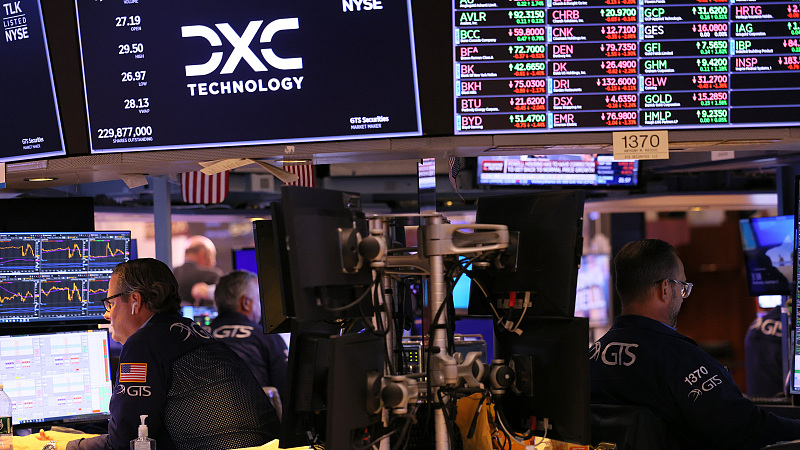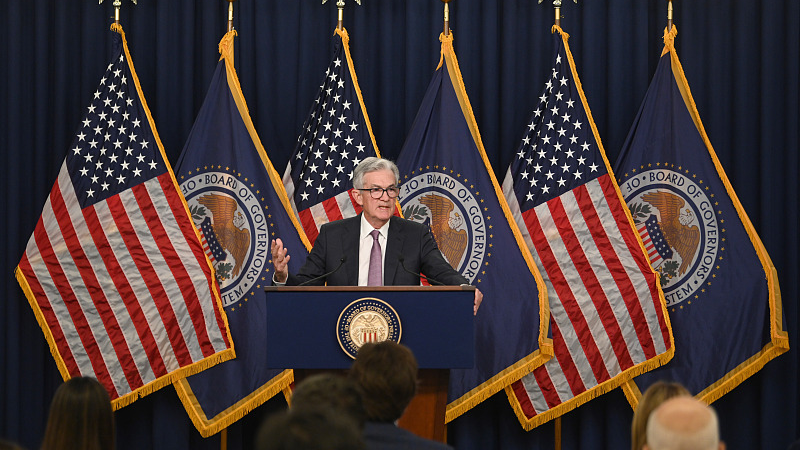
Traders work on the floor of the New York Stock Exchange,New York, September 21, 2022. /CFP
Traders work on the floor of the New York Stock Exchange,New York, September 21, 2022. /CFP
Editor's note: Huang Yongfu is an economic affairs commentator. After earning a PhD, he started his career at the University of Cambridge and then moved on to the UN system. His current interests lie in global development and Sino-U.S. links. The article reflects the author's opinions and not necessarily the views of CGTN.
The U.S. Labor Department has recently released two reports. The inflation report issued on October 13 shows a sign of persistent inflation, where the so-called core consumer-price index (CPI) accelerated to a new four-decade high, reaching 6.6 percent in September from a year earlier. The employment report issued on October 8 indicates the unemployment rate was going down to 3.5 percent last month from 3.7 percent in August, showing little sign of a reverse of jobs tightness in the market and a serious economic slowdown as fast as the U.S. Federal Reserve hopes.
The two reports reflect a political crisis with the public losing trust in the Biden administration and the Fed, with the latter seemingly losing its way. To tame inflation running near 40-year highs, the Fed has followed the economic policy of former Fed chairman Paul Volcker to raise rates at the most rapid pace since the 1980s.
However, prices have been widely believed to be driven up by constrained supply-chains and strong consumer demand. Mechanically following the 40-year-old economic policy to squeeze demand will not deliver the expected outcome, but could potentially trigger a global recession.
The two reports should have political ramifications amid the forthcoming midterm elections, as a virulent inflation has become entrenched in expectations and across much of the economy, punishing Americans at every corner.
Applying 40-year-old economic policy risks another blunder
Americans can attribute the current predicament of inflation to Congress for generous COVID-19 spending blowouts and the Fed for two policy blunders.
Starting in August 2020, the Fed officers and establishment economists of all kinds labeled the emerging inflation as "transitory" and failed to anticipate the threat until the persistently rising inflation became too obvious to ignore. Misled by the Modern Monetary Theory which argues that "by printing money, the government can finance its deficits at zero cost," the Fed has been criticized for maintaining "an expansionary monetary policy for too long" in Washington's "free-lunch" fantasy, even though the economy was booming last year.
With the return of soaring prices after a 40-year hiatus, the Fed has made an abrupt change of course by imitating indiscriminately the strategy of pre-emptive restraint, promoted by former Chair of the Fed, Paul Volcker in the 1980s. The Fed's current Chairman, Jerome Powell has framed the Fed's objective and single mandate of bringing down high prices as an "unconditional" obligation and indicated the acceptance of a recession as the price of fighting inflation.
The Fed has lifted rates by 0.75 percentage points at each of its past three meetings, its steepest increase since the 1980s. The minutes of the September 20-21 gathering, released on October 12, reaffirm a clear commitment to remain on aggressive tightening and suggest a further rate hike of the same scale next month, even as over-tightening risks are coming into view.
The strategy of pre-emptive restraint is expected to anchor inflationary expectations by tightening before inflation takes hold. After being appointed as Fed chair in 1979, Paul Volcker allowed interest rates to rise dramatically to reverse double-digit price gains in the 1980s, delivering price stability for nearly 40 years. Alan Greenspan, Volcker's successor, and Janet Yellen continued pre-emptive rate increases in mid-1994 and December 2016, respectively.
However, macroeconomic conditions between the 1970s and this time are different, in spite of considerable similarities.

Federal Reserve Chairman Jerome Powell attends a press conference, Washington, the U.S., September 21, 2022. /CFP
Federal Reserve Chairman Jerome Powell attends a press conference, Washington, the U.S., September 21, 2022. /CFP
Similarities and differences of macroeconomic conditions between then and now
The era of the Great Inflation between 1973 and 1982 was characterized by the Vietnam War and the War on Poverty in the 1960s, the Yom Kippur war of 1973 and the Iran-Iraq war in 1980. These shocks triggered Congress to enact a huge amount of federal spending, the Fed to pursue an easy-money policy and oil prices to jump. For example, at the urging of the Johnson administration, the Congress’ "guns and butter" policy for both the Vietnam War and the War on Poverty in 1966 produced a double-digit surge in federal spending.
Average inflation between 1973 and 1982 reached 9.2 percent, three times the average inflation rates of 3.3 percent from 1946 to 1972 and 2.7 percent from 1982 to 2019. It was the sharp disinflation under Volcker, the aggressive fiscal policy of the Reagan administration and the Reagan-Thatcher shift towards free markets that broke the back of the 20th century's most destructive inflation. That period ended in the early 1980s, with a wave of debt crises in developing countries, especially in those of Latin America. Similarly, the current inflation crisis taking place in the U.S. has been associated with shocks, such as COVID-19 and the Ukraine crisis. The Congress approved a large amount of stimulus programs, while the Fed pursued an easy-monetary policy by keeping interest rates low and expanding money supply at the fastest rate in post-war history in terms of buying or offsetting three-quarters of all the government debt incurred.
However, the circumstances this time are rather different. The current period is full of pervasive uncertainty where we did not have any idea about when the Ukraine crisis will end, when the COVID-19 outbreak can be effectively controlled, and how geopolitical tensions will unfold.
Apart from differences in demographic shifts, and technological changes, public debt levels are a far cry from the 1970s. With monetary policy tightening being prolonged, messy and costly debt crises are looming.
The indebted world economy is more fragile than 40 years ago
From the international financial institution's annual meetings in Washington last week, "more than 60 percent of low-income countries are in debt distress or near it."
Partly because the borrowing costs worldwide fell to sub-zero in the past two decades, both developed and emerging countries have become so indebted, with interest costs remaining far off their peak in the 1980s. The stock of global debt has grown from $83 trillion or 230 percent of GDP in 2000 to around $295 trillion or 355 percent in 2021, a rate nearly double the pace of world GDP growth.
According to an estimate by The Economist, the interest costs that households, companies, financial firms and governments worldwide had to pay were $10.2 trillion in 2021, equivalent to 12 percent of GDP, and will exceed $16 trillion by 2026, equivalent to 15 percent of projected GDP in that year.
The U.S.'s debt costs and debt sustainability have also become real issues. America's gross national debt exceeded $31 trillion for the first time on October, reaching a debt milestone level the U.S. has only reached during wartime. The number will be a jaw-dropping one once its military aid to support Ukraine against Russia has been added on. Roughly speaking, its debt costs increase $100 billion or more a year by every percentage point increase in rates.
The way forward
The two reports are a wake-up call for the U.S. policymakers, showing that squeezing demand only will not be sufficient to tame inflation.
The current surge in inflation is the result not only of strong domestic demand, but also global disruptions, more specifically geopolitical tensions or war, natural disasters and the U.S.'s protectionist policies against geopolitical rivals repeatedly stress global supply networks.
The U.S.'s championing globalization, giving up disruptions into global supply chains and taking actions to improve Sino-U.S. relationships will be indispensable to dent inflation.
(If you want to contribute and have specific expertise, please contact us at opinions@cgtn.com. Follow @thouse_opinions on Twitter to discover the latest commentaries in the CGTN Opinion Section.)